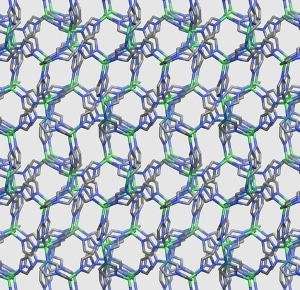Oct 11 2017
Metal-organic frameworks (MOFs) have extraordinary porosity allowing the transport or trapping of molecules. As they are in powder form, it is very challenging to format them.
An international group headed by Researchers from the Institut de recherche de Chimie Paris (CNRS/Chimie ParisTech)—and specifically involving Air Liquide—has demonstrated the astonishing potential of a class of MOF to preserve their porous characteristics in liquid as well as glass states. The outcomes of the study have been reported on the Nature Materials website on October 9th 2017, and they pave the way for innovative industrial applications.
 Crystalline structure of the ZIF-4 material at room temperature. CREDIT: F.-X. Coudert/CNRS.
Crystalline structure of the ZIF-4 material at room temperature. CREDIT: F.-X. Coudert/CNRS.
MOFs are a specifically prospective type of materials. Their unprecedented porosity renders it propitious to store and isolate huge volumes of gas, or to function as a catalyst used for chemical reactions. Yet, their crystalline structure indicates that they are synthesized in powder form, restricting their easy storage and application for industrial usage.
At present, Researchers from the CNRS, Chimie ParisTech, Cambridge University, Air Liquide and the ISIS (UK) and Argonne (US) synchrotrons have demonstrated that the characteristics of a zeolitic MOF were unexpectedly preserved in the liquid form. Normally, the liquid form does not favor porosity.
Upon being cooled and solidified, the acquired glass embraced a non-crystalline, disordered structure that also preserved the same characteristics with respect to porosity. These results will enable the shaping and use of these materials much more efficiently than in powder form.
In order to accomplish this, the Researchers adopted X-rays and neutron diffraction to examine the MOF’s structure upon melting, as soon as it changes to the liquid phase. These data were correlated with molecular simulations that replicated temperature conditions similar to those applied to the MOF for melting.
Integration of both the techniques allowed the Researchers to delineate the structural modifications impacting the material as it was liquefied and re-solidified again. Thus, they could exhibit an atypical mechanism.
The MOF that was investigated was formed of pyramidal molecular frameworks, where each framework comprised of a zinc atom enclosed by four organic, cyclical molecules known as imidazolates. The energy produced upon melting, due to the increase in temperature, was adequate enough to disconnect the link between zinc and an imidazolate, thereby dismantling the pyramidal framework.
The original structure is recreated when the ensuing space is occupied by one more imidazolate cycle liberated by an adjacent framework. The MOF acquires its liquid properties from these molecular exchanges among complex structures.
Considering this specific MOF, porosity was caused due to the existence of gaps between the pyramidal structures that can be filled by gases. As the pyramidal structure of the MOF in the liquid state was retained the same, its porosity was also retained. Apart from describing the potential of the MOF to retain its characteristics upon being melted, the research also outlines the properties of a porous liquid, which is not investigated to a greater extent.